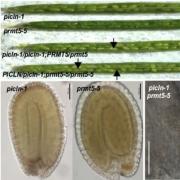bioRxiv with Yanovsky lab: Light, temperature and alternative splicing
PICLN modulates alternative splicing and ensures adaptation to light and temperature changes in plants
Julieta L. Mateos et al. (2022) bioRxiv 496170 doi.org/10.1101/2022.06.14.496170
Plants undergo transcriptome reprogramming to adapt to daily and seasonal fluctuations in light and temperature conditions. While most efforts have focused on the role of master transcription factors, the importance of splicing factors modulating these processes is now emerging. Efficient pre-mRNA splicing depends on proper spliceosome assembly, which in plants and animals requires the PRMT5-methylosome complex. PICLN is part of the PRMT5-methylosome complex in both humans and Arabidopsis thaliana, and we show here that the human PICLN ortholog rescues phenotypes of A. thaliana picln mutants. Altered photomorphogenic and photoperiodic responses in A. thaliana picln mutants are associated with changes in pre-mRNA splicing, which partially overlap with those in prmt5 mutants. Mammalian PICLN also acts in concert with the Survival Motor Neuron (SMN) complex component GEMIN2 to modulate the late steps of UsnRNP assembly, and many alternative splicing events regulated by PICLN but not PRMT5 are controlled
 by A. thaliana GEMIN2. As with GEMIN2 and SME1/PCP, low temperature, which increases PICLN expression, aggravates morphological and molecular defects of picln mutants. Taken together, these results establish a key role for PICLN in the regulation of pre-mRNA splicing and in mediating plant adaptation to daily and seasonal fluctuations in environmental conditions.
by A. thaliana GEMIN2. As with GEMIN2 and SME1/PCP, low temperature, which increases PICLN expression, aggravates morphological and molecular defects of picln mutants. Taken together, these results establish a key role for PICLN in the regulation of pre-mRNA splicing and in mediating plant adaptation to daily and seasonal fluctuations in environmental conditions.



